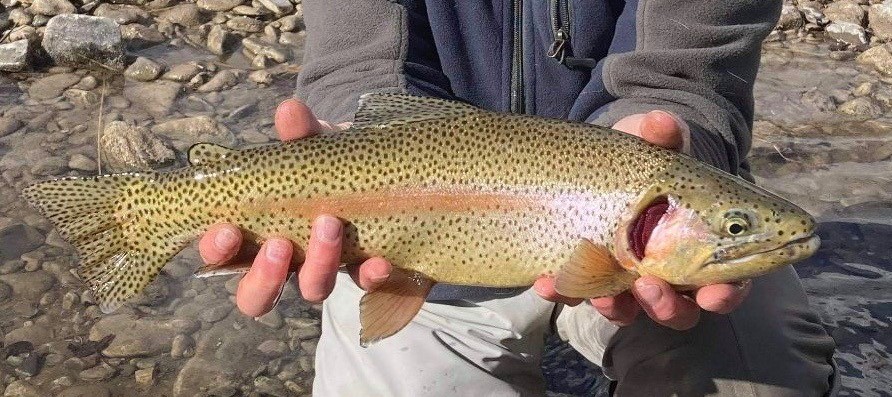If Trout Could Talk: Coal and the Eastern Slopes
16 April 2025

By LORNE FITCH, P. Biol.
In the coal saga, there’s more to mine than the mountain. Despite protestations of due diligence and highest engineering standards, every coal mine in the Eastern Slopes has had spectacular environmental failures; most of them on a regular basis. This is a function of topography, engineering failures, and an inability to incorporate the effects of weather events into mine design. For a lesson about future mines, all one must do is review past mines.
Pit wall collapses, settling pond failures, conveyance system upsets, and mine road washouts are the most visible evidence of problems. But it is the liberation of a witches’ brew of toxic chemicals that creates legacy issues. Selenium, antimony, cobalt, lithium, manganese, molybdenum, nickel, strontium, thallium, uranium, and many others are released for decades by the weathering of the shattered caprock overburden.
Hidden in the labyrinth of the Benga environmental impact assessment report for the proposed Grassy Mountain mine is a cryptic note on the analysis of selenium in the flesh of trout from Gold and Blairmore creeks.¹ Selenium concentrations in the trout were significantly higher than limits adopted by both B.C. and Alberta² to protect fish populations from collapse, despite selenium concentrations in these streams being lower than guidelines. This information never came up in the Joint Review Panel hearing although there was evidence enough to damn the project.
Contamination of fish isn’t restricted to the Crowsnest watershed. Evidence from other watersheds with coal strip mines show similar results for elevated selenium concentrations in fish, including the coal industry’s much-promoted reclaimed mine pit lakes.³
Furthermore, contamination isn’t restricted to fish. Bighorn sheep living on reclaimed coal mines in the Coal Branch region of Alberta have selenium concentrations in their tissues higher than bighorns in any other place in North America.
Native cutthroat trout used to exist in East Crowsnest Creek and the headwaters of Crowsnest Creek, beneath the Tent Mountain coal mine. Very high selenium concentrations from the mine spoil, coupled with excessive sediment loadings to these streams is implicated in trout disappearance.⁴
The selenium guideline values adopted by past B.C. and Alberta governments were developed after multiple fish populations collapsed after exceeding these values. The population crashes informed us that there is a limit to the amount of selenium pollution fish populations can absorb before they disappear.
Trout aren’t just the quarry for a few anglers. Like the canary in the coal mine, trout alert us to the impacts of coal mining by being an early warning indicator and the bellwethers of danger. To ignore their message is to ignore our own peril.
A fundamental message from the selenium contamination of trout is that we need to look beyond what is found in the water, to how it bioaccumulates up the food chain, to levels of significant health concern. Remember that we are at the top of that food chain.
These are some of the things to mine in our deliberations over coal mining in the Eastern Slopes. We might also reflect on the misinformation and distortion coated in the fairy dust of illusionary economic benefits. Overseeing this is an arm’s-length regulator being politically manipulated.
Arrayed against this are the clearly articulated wishes of most Albertans who are passionate about a mine-free Eastern Slopes. Alberta recently went through a review of coal policy by an independent panel. This panel was responsible for the largest public engagement process in Alberta’s history to define a path forward for coal. Their recommendations have yet to be implemented.
We have recently witnessed a muddled, barely coherent “clarification” of coal policy from the Minister of Energy to the Alberta Energy Regulator (AER). The letter was issued during an ongoing AER hearing into a coal exploration application, and it opens a question of whether it was attempting to fetter that process.
This retreat from the wishes of Albertans effectivity winds the clock back, reinstates exploration permits, and opens new exploration, including construction of new roads that will erode for years. Nothing else has changed, including the continual leaching of selenium into Eastern Slope rivers; no timely, effective reclamation of coal exploration roads; and growing citizen frustration.
Utah Phillips was a folk singer and philosopher who is credited with once saying: “The Earth is not dying — it is being killed. And the people who are killing it have names and addresses.” These names are writ large on this public policy failure to protect the Eastern Slopes.
Lorne Fitch is a Professional Biologist, a retired Fish and Wildlife Biologist and a past Adjunct Professor with the University of Calgary. He is the author of Streams of Consequence: Dispatches from the Conservation World and Travels Up the Creek: A Biologist’s Search for a Paddle.
Read the Original Article for this Post
For a richer reading experience, view this article in the professionally designed online magazine with all images and graphs in place.
This article originally ran in the Spring 2025 issue of Nature Alberta Magazine (Vol. 55 | No. 1).


